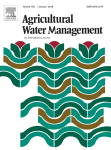Ver ítem
- xmlui.general.dspace_homeCentros Regionales y EEAsCentro Regional Mendoza - San JuanEEA San JuanArtículos científicosxmlui.ArtifactBrowser.ItemViewer.trail
- Inicio
- Centros Regionales y EEAs
- Centro Regional Mendoza - San Juan
- EEA San Juan
- Artículos científicos
- Ver ítem
Water relations, biochemical – physiological and yield responses of olive trees (Olea europaea L. cvs. Arbequina and Manzanilla) under drought stress during the pre-flowering and flowering period
Resumen
In arid and semiarid regions from Argentina, where the main olive production areas are located, evapotranspiration is high and rainfall is minimal during winter and spring months, as compared with the Mediterranean region where winter rainfall precludes the need of irrigation in such period. The aim of the work was to study water relations, biochemical–physiological and yield responses of olive trees (Olea europaea L., Arbequina and Manzanilla cultivars)
[ver mas...]
In arid and semiarid regions from Argentina, where the main olive production areas are located, evapotranspiration is high and rainfall is minimal during winter and spring months, as compared with the Mediterranean region where winter rainfall precludes the need of irrigation in such period. The aim of the work was to study water relations, biochemical–physiological and yield responses of olive trees (Olea europaea L., Arbequina and Manzanilla cultivars) under different drought stress levels applied during the pre-flowering–flowering period. Increasing levels of water deficit affected plant water relations as measured by pronounced drops of stem water potentials (near −4.0 MPa) in treatments with severe water deprivation at the end of the flowering period. Deficit irrigation was associated with some leaf-level biochemical-physiological responses (accumulation of osmotically active substances, increased concentration of high molecular weight hydrocarbons and cuticle thickening), which can be interpreted as adaptation mechanisms of olive to water deficit. Water stress was also associated with increased lipid peroxidation and decreased levels of photosynthetic pigments, stomatal conductance and photosynthetic rate. During the first crop year analyzed, a significant decrease in fruit set and fruit yield was observed in treatments under water deprivation. Also, all treatments evaluated showed strong drops in fruiting and yield parameters during the second crop year suggesting a marked bearing pattern for both olive cultivars. From a practical standpoint, little irrigation (50% ETc) may be sufficient to maintain adequate plant water potentials for the coldest winter months, but high (75% ETc) or full (100% ETc) irrigation rates could be needed by mid-August (approximately 2 months before flowering) to avoid detrimental effects of water stress on biochemical–physiological and yield parameters of olive trees cultivated in areas with dry winter-spring season.
Previous article in issue
Next article in issue
Abbreviations
CarCarotenoidsChl-aChlorophyll aChl-bChlorophyll bDWDry weightETcEstimated crop evapotranspirationEToReference evapotranspirationEVEnding valueGCGas chromatographyGC - MSGas chromatography–mass spectrometrygsStomatal conductanceIVInitial valueIWPIrrigation water productivityMDAMalondialdehydePhaePhaeophytinPnPhotosynthetic ratePROProlineRDIRegulated deficit irrigationROSReactive oxygen substancesTLCThin layer chromatographyΨstemStem water potential
[Cerrar]

Autor
Pierantozzi, Pierluigi;
Torres, Myriam Mariela;
Bodoira, Romina Mariana;
Maestri, Damian;
Fuente
Agricultural water management 125 : 13-25. (July 2013)
Fecha
2013-07
Editorial
Elsevier
ISSN
0378-3774
Formato
pdf
Tipo de documento
artículo
Palabras Claves
Derechos de acceso
Restringido
 Excepto donde se diga explicitamente, este item se publica bajo la siguiente descripción: Creative Commons Attribution-NonCommercial-ShareAlike 2.5 Unported (CC BY-NC-SA 2.5)
Excepto donde se diga explicitamente, este item se publica bajo la siguiente descripción: Creative Commons Attribution-NonCommercial-ShareAlike 2.5 Unported (CC BY-NC-SA 2.5)

